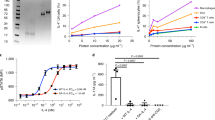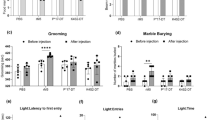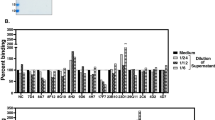Abstract
EXPERIMENTAL allergic encephalomyelitis (EAE) is an acute neurological autoimmune disease induced in laboratory animals such as guinea-pigs, rabbits, rats and monkeys by administration in complete Freund's adjuvant of a basic encephalitogenic protein (BE) isolated from the brain or spinal cord of several animal species1. We have recently shown2 that the disease may be suppressed by intravenous injection of a synthetic amino-acid copolymer (denoted Cop 1). This copolymer is composed of alanine, glutamic acid, lysine and tyrosine, in a residue molar ratio of 6.0 : 1.9 : 4.7 : 1.0, and has an average molecular weight of 23,000. This basic polymer is not encephalitogenic2 and is not a general non-specific immunosuppressive agent (our unpublished results). Whereas it efficiently suppresses the disease when administered after the basic encephalitogen, it cannot prevent the disease when injected intravenously in saline before the basic brain protein2.
This is a preview of subscription content, access via your institution
Access options
Subscribe to this journal
Receive 51 print issues and online access
$199.00 per year
only $3.90 per issue
Buy this article
- Purchase on Springer Link
- Instant access to full article PDF
Prices may be subject to local taxes which are calculated during checkout
Similar content being viewed by others
References
Paterson, P. Y., Adv. Immunol., 5, 131 (1966).
Teitelbaum, D., Meshorer, A., Hirshfeld, T., Arnon, R., and Sela, M., Europ. J. Immunol., 1, 242 (1971).
Svet-Moldavskaya, I. A., and Svet-Moldavsky, G. J., Nature, 181, 1536 (1959).
Svet-Moldavsky, G. J., Svet-Moldavskaya, I. A., and Raffkina, L. I., Nature, 184, 1552 (1959).
Paterson, P. Y., Harwin, S. M., and Didakow, N. C., J. Clin. Invest., 40, 1069 (1961).
Kies, M. W., Shaw, C. M., Fahlenberg, W. J., and Alvord, jun., E. C., Ann. Allergy, 18, 849 (1960).
Shaw, C. M., Fahlenberg, W. J., Kies, M. W., and Alvord, jun., E. C., J. Exp. Med., 111, 171 (1962).
Shaw, C. M., Alvord, jun., E. C., Fahlenberg, W. J., and Kies, M. W., J. Immunol., 89, 54 (1962).
Roboz-Einstein, E., Cjestey, J., Davis, W. J., and Rauch, H. C., Immunochemistry, 5, 567 (1968).
Lisak, R. P., Falk, G. A., Heinze, R. G., Kies, M. W., and Alvord, jun, E. C., J. Immunol., 104, 1435 (1970).
Eylar, E. H., in Immunologic Disorders of the Nervous System (edit. by Rowland, L.), 5 (Academic Press, New York, 1971).
Eylar, E. H., Jackson, J., Rothenberg, B., and Brostoff, S. W., Nature, 238, 74 (1972).
Anderson, J. R., Buchanan, W. W., and Goudie, R. B., in Autoimmunity (Thomas, Springfield, 1967).
Author information
Authors and Affiliations
Rights and permissions
About this article
Cite this article
TEITELBAUM, D., WEBB, C., MESHORER, A. et al. Protection against Experimental Allergic Encephalomyelitis. Nature 240, 564–566 (1972). https://doi.org/10.1038/240564b0
Received:
Revised:
Issue Date:
DOI: https://doi.org/10.1038/240564b0
This article is cited by
-
What do we know about the mechanism of action of disease-modifying treatments in MS?
Journal of Neurology (2004)
-
Failure of myelin basic protein to prevent or suppress experimental allergic encephalomyelitis in guinea pigs
Neurochemical Research (1980)
-
Regulation of autosensitisation to encephalitogenic myelin basic protein by macrophage-associated and soluble antigen
Nature (1977)
-
Failure of basic protein therapy for multiple sclerosis
Journal of Neurology (1977)
Comments
By submitting a comment you agree to abide by our Terms and Community Guidelines. If you find something abusive or that does not comply with our terms or guidelines please flag it as inappropriate.



